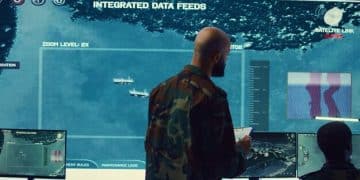US Military Cyber Command: New Strategies Against Evolving Cyber Threats

The US Military Cyber Command is continuously evolving its strategies and defenses to counter sophisticated and diversifying cyber threats, ensuring national security in an increasingly digitized global landscape.
In an era defined by rapid technological advancement, the battlespace has expanded far beyond traditional land, sea, and air. The digital domain, often referred to as the fifth dimension of warfare, presents both unprecedented opportunities and formidable challenges. Navigating this complex landscape requires a highly specialized and agile entity. This is precisely the role of the US Military Cyber Command: How New Strategies are Defending Against Evolving Threats, a critical component of national security dedicated to safeguarding crucial networks and systems from an ever-growing array of cyber adversaries.
The evolving nature of cyber warfare
Cyber warfare is no longer a theoretical concept; it is a daily reality. Adversaries, both state-sponsored and independent, are constantly refining their tactics, techniques, and procedures (TTPs) to exploit vulnerabilities and achieve strategic objectives. This dynamic environment necessitates continuous adaptation and innovation.
The conventional military doctrines of the past were ill-equipped to address the complexities of digital conflict. Unlike physical battles, cyber attacks can originate from anywhere in the world, often with little to no attribution, causing widespread disruption without a single shot being fired. The speed at which these attacks unfold also demands an immediate and robust response.
Defining the modern cyber threat landscape
The threats faced by the US Military Cyber Command are multifaceted, ranging from espionage and intellectual property theft to critical infrastructure disruption and disinformation campaigns. Understanding the diverse nature of these threats is the first step in formulating effective defense strategies.
- State-sponsored actors: Highly sophisticated groups backed by nation-states, often targeting critical infrastructure, defense systems, and government networks for geopolitical advantage.
- Cyber terrorist groups: Organizations using cyber means to instill fear, disrupt public services, or propagate extremist ideologies.
- Organized cybercrime syndicates: Although primarily financially motivated, their tactics and tools frequently overlap with those used by state actors, posing a significant risk to military supply chains and personnel data.
- Insider threats: Disgruntled employees or agents within an organization who can leverage their access to compromise systems from within.
The speed and scale of these attacks are also increasing. What once took weeks or months to plan and execute can now be accomplished in days or even hours, thanks to increasingly advanced automated tools and readily available exploit kits on the dark web. This rapid evolution demands a proactive and adaptive cyber defense.
Furthermore, the convergence of cyber warfare with traditional military operations is becoming more pronounced. Cyber attacks can be used to precede, accompany, or follow kinetic actions, making them an integral part of modern military doctrine. This integration requires seamless coordination between cyber operators and traditional military units.
Cyber Command’s foundation and mission
Established in 2010, the US Cyber Command (USCYBERCOM) emerged from the recognition that the digital domain required a dedicated military response. Its foundational mission is clear: to direct, synchronize, and coordinate cyberspace operations to deter attacks against the US and its allies, and to defend US Department of Defense (DoD) networks.
Initially formed under the strategic command of the National Security Agency (NSA), USCYBERCOM has evolved significantly. In 2018, it was elevated to a unified combatant command, reflecting its growing importance and strategic autonomy. This elevation underscored the critical nature of cyberspace operations to national security.
Key pillars of USCYBERCOM’s mandate
The command operates under several core principles that guide its offensive and defensive missions. These pillars ensure a comprehensive approach to securing the digital battlespace.
- Defend forward: Engaging adversaries in cyberspace before their actions can impact US networks and interests, often by operating within foreign networks or in internationally recognized cyberspace.
- Persistent engagement: Acknowledging that cyber conflict is a continuous state, maintaining an ongoing presence in contested digital spaces to understand and disrupt adversary operations.
- Integrated deterrence: Combining cyber capabilities with traditional military power and diplomatic efforts to dissuade potential adversaries from malicious cyber activities.
These principles require a highly skilled workforce, advanced technologies, and robust partnerships. USCYBERCOM is heavily invested in recruiting and training top cyber talent, from coders and analysts to exploit developers and incident responders. The human element remains paramount in the face of machine-driven threats.
The command also places a high emphasis on information sharing and collaboration, both internally within the DoD and with external partners. This includes intelligence agencies, law enforcement, and critical infrastructure owners, recognizing that a holistic defense requires a unified effort across multiple sectors.
Proactive defense strategies: From active defense to hunt forward
The traditional approach to cybersecurity was often reactive, focusing on building stronger walls and responding after an intrusion. However, the nature of modern cyber threats necessitates a proactive stance. USCYBERCOM has pioneered strategies like “active defense” and “hunt forward” to gain an advantage.
Active defense involves actively monitoring, identifying, and disrupting adversary activities in cyberspace. It’s a shift from merely protecting networks to actively seeking out and neutralizing threats before they can inflict damage. This requires advanced threat intelligence and the ability to operate effectively within adversary networks.
The philosophy of hunt forward operations
Hunt forward operations are a cornerstone of USCYBERCOM’s proactive strategy. These missions involve deploying US cyber operators to partner nations’ networks, at their invitation, to search for and identify malicious cyber activities. This collaborative approach serves multiple purposes.
- Early threat detection: Identifying adversary TTPs far from US borders, providing valuable intelligence that can be used to bolster defenses at home.
- Enhanced partnerships: Strengthening alliances by sharing expertise and building joint capabilities in cyber defense.
- Adversary disruption: Directly impacting the ability of adversaries to conduct operations by exposing and remediating their tools and infrastructure.
These operations are conducted with strict legal and policy oversight, ensuring they are consistent with international law and the sovereignty of partner nations. The intelligence gathered from hunt forward missions is often shared with the broader intelligence community and even with critical infrastructure sectors to improve collective defense.
The effectiveness of proactive defense lies in its ability to complicate an adversary’s planning and execution. By disrupting their operations early, USCYBERCOM can increase the cost and risk for malicious actors, thereby deterring future attacks. This strategic approach helps to shift the balance of power in the digital domain, making it more challenging for adversaries to achieve their objectives undetected.
Integrating artificial intelligence and machine learning
The sheer volume and complexity of data generated in cyberspace are overwhelming for human analysts alone. Cyber attacks often occur at machine speed, requiring automated responses and advanced analytical capabilities. This is where artificial intelligence (AI) and machine learning (ML) become indispensable tools for USCYBERCOM.
AI and ML algorithms can process vast amounts of network traffic, identify anomalous behavior, detect novel threats, and even predict potential attack vectors with a speed and accuracy far beyond human capacity. These technologies are revolutionizing how the military defends its cyber terrain.
Applications of AI in cyber defense
The integration of AI and ML spans various aspects of cyber operations, from defensive measures to intelligence gathering.
- Threat detection and prediction: AI-powered systems can analyze network logs and traffic patterns to identify indicators of compromise (IOCs) and predict where and when attacks are likely to occur.
- Automated response: ML models can be trained to automatically neutralize threats, isolate infected systems, or reroute traffic to mitigate the impact of an attack in real-time.
- Vulnerability assessment: AI can rapidly scan and identify weaknesses in software and hardware, allowing for proactive patching and strengthening of defenses.
- Deception technologies: AI can be used to create realistic honeypots and lures, trapping adversaries and gathering intelligence on their TTPs.
However, the adoption of AI is not without its challenges. Ensuring the trustworthiness and explainability of AI models is crucial, especially in mission-critical applications. Bias in training data can lead to skewed results, and adversarial AI techniques can be used to trick or evade AI-based defenses.
USCYBERCOM is actively investing in research and development to overcome these hurdles, fostering collaboration with academic institutions and private industry. The goal is to develop robust, resilient, and adaptive AI systems that can operate effectively in the volatile cyber environment, ensuring a technological edge over adversaries. The ethical implications of AI in warfare are also a continuous area of focus, ensuring responsible deployment and adherence to international norms.

Cyber resilience and infrastructure hardening
Beyond offensive and defensive operations, a key component of USCYBERCOM’s strategy is fostering cyber resilience. This involves building networks and systems that can withstand attacks, recover quickly from disruptions, and continue operating even when compromised. It’s about accepting that some intrusions are inevitable and preparing for them.
Infrastructure hardening refers to the process of securing systems by reducing their attack surface and eliminating known vulnerabilities. This includes regular patching, configuration management, network segmentation, and the implementation of robust identity and access management controls.
Building a resilient digital ecosystem
Achieving true cyber resilience requires a multi-layered approach, encompassing technological solutions, procedural improvements, and human training.
- Zero trust architecture: Assuming that no user or device, whether inside or outside a network, should be trusted by default. Every access request is authenticated and authorized.
- Advanced encryption: Protecting data at rest and in transit through strong cryptographic methods, rendering stolen data useless to adversaries.
- Redundancy and diversity: Designing systems with backup capabilities and using diverse technologies to prevent single points of failure.
- Incident response planning: Developing detailed plans for how to detect, contain, and recover from cyber incidents, and regularly testing these plans through drills and exercises.
The human element is also critical to resilience. Training personnel to recognize phishing attempts, identify social engineering tactics, and follow secure computing practices can significantly reduce the risk of successful attacks. A well-informed workforce acts as an additional layer of defense.
Furthermore, maintaining an up-to-date inventory of all network assets, understanding their interdependencies, and continuously monitoring their health are essential for rapidly detecting and responding to threats. Cyber resilience is an ongoing process, requiring constant vigilance and adaptation to new threats and technologies. It’s about designing systems for failure, ensuring that even if one component is compromised, the overall mission can continue unimpeded.
International collaboration and deterrence
Cyber threats are inherently transnational, transcending geographical borders and traditional alliances. No single nation can effectively combat these threats in isolation. Therefore, international collaboration is paramount to the US Military Cyber Command’s strategy for defending against evolving threats.
USCYBERCOM actively engages with allies and partners around the globe, sharing threat intelligence, conducting joint exercises, and building collective capacity. This collaborative approach strengthens global cybersecurity and enhances collective deterrence against malicious cyber actors.
Forging alliances in the digital domain
Collaboration takes many forms, from bilateral agreements to multilateral initiatives, each designed to address different aspects of the cyber threat.
- Information sharing agreements: Establishing formal channels for sharing real-time threat intelligence, indicators of compromise, and best practices.
- Joint cyber exercises: Conducting simulated cyberattacks and defense scenarios with allied nations to improve interoperability and response coordination.
- Capacity building: Assisting partner nations in developing their own cyber defense capabilities, strengthening the overall global cybersecurity posture.
- Norms of responsible state behavior: Working with the international community to establish clear rules and expectations for state conduct in cyberspace, aiming to reduce miscalculation and escalation.
These collaborative efforts contribute significantly to deterrence. By demonstrating a united front and collective resilience, the international community signals to potential adversaries that cyber aggression will be met with a strong and coordinated response. This reduces the incentive for malicious actors to launch attacks.
The challenge lies in aligning diverse national interests and legal frameworks. However, the shared understanding of the common threat posed by cyber adversaries often outweighs these differences. International cooperation is not just about defense; it’s about shaping the future of cyberspace, ensuring it remains open, secure, and reliable for all. The persistent engagement strategy extends to these international partnerships, fostering long-term relationships built on trust and shared objectives.

The future of cyber warfare and USCYBERCOM’s role
The landscape of cyber warfare is constantly shifting, driven by technological innovation and evolving geopolitical dynamics. Anticipating future threats and adapting accordingly is crucial for USCYBERCOM’s continued effectiveness.
Emerging technologies like quantum computing, advanced AI, and the widespread adoption of the Internet of Things (IoT) present both new vulnerabilities and new opportunities for defense. The command must remain at the forefront of these developments to maintain its strategic advantage.
Anticipating future challenges and opportunities
Preparing for the future involves continuous research, strategic foresight, and agile adaptation.
- Quantum-resistant cryptography: Developing and implementing cryptographic methods that can withstand attacks from future quantum computers, protecting classified information.
- Securing the IoT: Addressing the vast and expanding attack surface presented by billions of interconnected devices, from military sensors to smart cities.
- AI-driven cyber operations: Harnessing advanced AI for both offensive and defensive operations, including autonomous cyber agents and sophisticated data analysis.
- Space-based cyber warfare: Recognizing the increasing militarization of space and the potential for cyber attacks against satellite systems and space infrastructure.
The concept of “human-machine teaming” is also gaining prominence, where human operators leverage AI tools to augment their capabilities, rather than being replaced by them. This synergy can lead to more effective and efficient cyber operations.
USCYBERCOM’s role will continue to expand beyond traditional network defense to encompass a broader spectrum of strategic competition in cyberspace. This includes influencing the information environment, deterring malicious behavior, and ensuring freedom of action in the digital domain for the US and its allies. The challenges are formidable, but the command remains committed to ensuring national security in an increasingly digitized world.
| Key Area | Brief Description |
|---|---|
| 🛡️ Proactive Defense | Shift from reactive to proactive strategies, engaging adversaries globally before threats impact US networks. |
| 🤖 AI & Machine Learning | Leveraging AI/ML for rapid threat detection, automated response, and predictive analytics in complex cyber environments. |
| 🌐 International Collaboration | Forging alliances and sharing intelligence with partner nations to build collective cyber resilience and deter threats. |
| ⚙️ Cyber Resilience | Implementing robust measures like Zero Trust and advanced encryption to ensure network systems can withstand and quickly recover from attacks. |
Frequently asked questions about US Military Cyber Command
The primary mission of USCYBERCOM is to direct, synchronize, and coordinate cyberspace operations to deter attacks against U.S. interests and allies, defend DoD networks, and deliver capabilities for national security objectives. It works to ensure freedom of action in cyberspace for the U.S. and its partners.
“Hunt forward” is a proactive defense strategy where USCYBERCOM operators, invited by partner nations, deploy to their networks to seek out and identify malicious cyber activities originating from adversaries. This helps detect threats early, gather intelligence, and strengthen global cyber defenses from afar.
AI plays a crucial role by enabling rapid threat detection, predicting attack vectors, automating responses to intrusions, and continuously assessing vulnerabilities. It helps process vast amounts of data beyond human capacity, providing a critical technological edge against fast-evolving threats.
Cyber threats are transnational, meaning they cross borders and affect multiple nations. International collaboration allows for shared intelligence, joint exercises, and collective capacity building, strengthening global defenses and creating a unified front to deter state-sponsored and criminal cyber actors.
Cyber resilience refers to an organization’s ability to withstand, recover from, and adapt to cyberattacks while maintaining critical operations. It’s important because, despite best efforts, some intrusions are inevitable. Resilience ensures systems can continue functioning and recover quickly, minimizing disruption and impact.
Conclusion
The digital domain stands as a dynamic and increasingly critical frontier in global security. The US Military Cyber Command, through its relentless innovation, strategic adaptation, and robust international partnerships, remains at the vanguard of defending against evolving threats in this complex battlespace. From proactive “hunt forward” operations and the crucial integration of AI to fostering resilient infrastructure and championing global collaboration, USCYBERCOM’s multifaceted approach ensures that national interests are protected, vulnerabilities are minimized, and adversaries are deterred. As technology continues its relentless march forward, so too will the capabilities and strategies of the US Military Cyber Command, ensuring a continued commitment to safeguarding the digital future.





